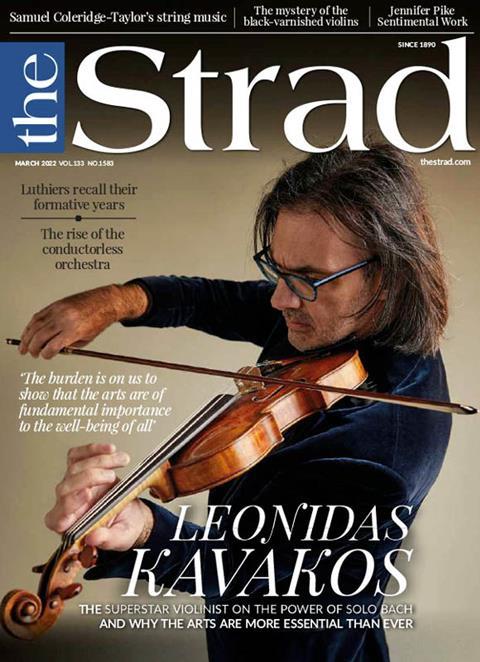In this extract from the March 2022 issue, violinist Lihay Bendayan provides tips on how to improve a weak fourth finger vibrato

The following extract is from The Strad’s March 2022 issue Technique: Developing a controlled vibrato. To read it in full, click here to subscribe and login. The March 2022 digital magazine and print edition are on sale now
Fourth-finger vibrato
Fourth-finger vibrato can be difficult because the fourth finger is weaker than the others, but it is important to develop it to match the others’ expressive range. With a strong, more capable fourth finger, your vibrato will be freer and you will have more control.
- Practise scales with a continuous, wide vibrato, using just 3 and 4
- Practise chromatics on 4 alone, from third position up. Up high the finger angle is flatter and it takes more pressure to push down the string, so widen and speed up your vibrato as you ascend
Work on extensions in parallel to build finger range and flexibility:
- In a high position, play a left-hand 1 followed by a 4, very slowly in alternation, with long, separate bows
- Move the 4 up half a position each time, always with a relaxed hand, wrist, fingers and thumb, and using minimal pressure
- Gradually shift down the instrument so that the intervals become larger. Try the exercise with vibrato and different fingerings.
Triggering the vibrato
To sharpen the impulses that you need in order to trigger vibrato, practise the following exercise. This is like throwing a pebble on the lake: once you can make the pebble skip once, the other skips will follow automatically. A good impulse will give you momentum, so that you can get better results with less effort:
- Play a scale in martelé, with full bows and maximum projection For each martelé impulse, start a very fast vibrato, to give a simultaneous burst of energy from both hands
- Lift the bow in an arc to end the stroke, then curve back down for the next ‘attack’
- Practise with different finger pressures and in legato, to check you can control left-hand impulses without disrupting the bow.
IN YOUR PRACTICE
Spend five minutes releasing tension at the beginning of every practice session, to improve awareness of your body before you begin. After this, it is a good idea to start without vibrato, to ensure that when you do introduce it, it is controlled and intentional.
To improve your vibrato, practise the exercises in this article daily for at least a month. When you can do this without tension and with absolute control, practise the exercises again using more complicated material, such as all the variations in Flesch’s scale system. Don’t overdo it: effective practice is about teaching ourselves how to achieve maximum output with minimum effort. From the moment we try to do too much, we add tension, lose control, and make everything more difficult.
TIPS FOR TEACHERS
When we work with students, it is important always to begin from a balanced, tension-free position, with a correct arm, hand and finger position relative to the strings. In all of these exercises it is not the notes that are important: it is understanding how the body works, so that we can help our students to create new exercises through which they can continually advance their techniques in increasingly complex contexts.
Teaching our students to develop controlled hand and arm vibratos, even if naturally they find one far easier to play than the other, is important to give them better control of their movements and the sound that they produce on the violin.
INTERVIEW BY PAULINE HARDING
Read: Technique: Developing a controlled vibrato
Read: Should vibrato exercises be practised separately from the repertoire?
-
This article was published in the March 2022 Leonidas Kavakos issue
The Greek violinist tells Charlotte Smith why his recording of Bach’s Solo Sonatas and Partitas is a culmination of a three-decade journey. Explore all the articles in this issue
More from this issue…
- Leonidas Kavakos
- Conductorless Orchestras
- Early Lutherie Experience
- Laura van der Heijden
- Luigi Cavallini
- Coleridge-Taylor Violin and Chamber Music
Read more playing content here
-

Violinist Lihay Bendayan: Fourth finger vibrato
- 1
 Currently reading
Currently readingViolinist Lihay Bendayan: Fourth finger vibrato
- 2
- 3
- 4
- 5
- 6
- 7
- 8
- 9
- 10
- 11
- 12





















































1 Readers' comment